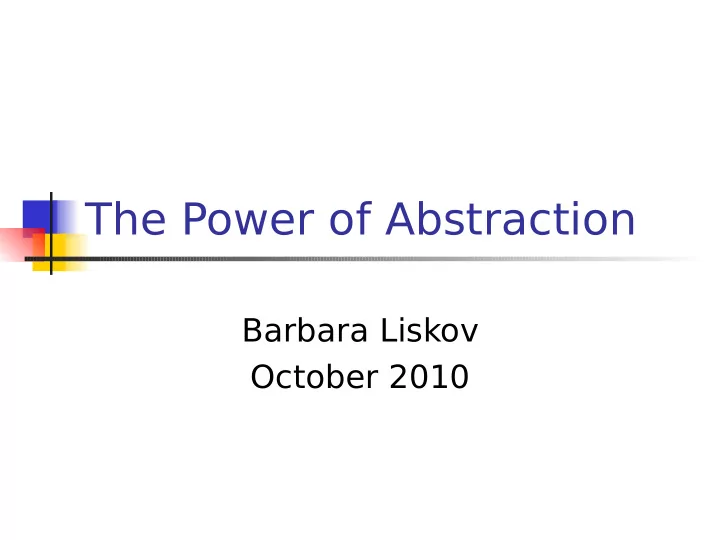

The Power of Abstraction Barbara Liskov October 2010
Outline Inventing abstract data types CLU Type hierarchy What next
Data Abstraction Prehistory The Venus machine
The Interdata 3
Data Abstraction Prehistory The Venus machine The Venus operating system
Data Abstraction Prehistory The Venus machine The Venus operating system Programming methodology
Programming Methodology How should programs be designed? How should programs be structured?
The Landscape E. W. Dijkstra. Go To Statement Considered Harmful. Cacm, Mar. 1968
The Landscape N. Wirth. Program Development by Stepwise Refinement. Cacm, April 1971
The Landscape D. L. Parnas. Information Distribution Aspects of Design Methodology. IFIP Congress, 1971 “The connections between modules are the assumptions which the modules make about each other.”
Partitions B. Liskov. A Design Methodology for Reliable Software Systems. FJCC, Dec. 1972
Partitions op1 op2 op3 Partition state
From Partitions to ADTs How can these ideas be applied to building programs?
Idea Connect partitions to data types
Meeting in Savanah ACM Sigplan-Sigops interface meeting. April 1973. (Sigplan Notices, Sept. 1973) Started to work with Steve Zilles
The Landscape Extensible Languages S. Schuman and P. Jourrand. Definition Mechanisms in Extensible Programming Languages. AFIPS. 1967 R. Balzer. Dataless Programming. FJCC 1967
The Landscape O-J. Dahl and C.A.R. Hoare. Hierarchical Program Structures. Structured Programming, Academic Press, 1972
The Landscape J. H. Morris. Protection in Programming Languages. Cacm. Jan. 1973
The Landscape W. Wulf and M. Shaw. Global Variable Considered Harmful. Sigplan Notices. Feb. 1973.
Abstract Data Types B. Liskov and S. Zilles. Programming with Abstract Data Types. ACM Sigplan Conference on Very High Level Languages. April 1974
What that paper proposed Abstract data types A set of operations And a set of objects The operations provide the only way to use the objects
What that paper proposed Abstract data types Clusters with encapsulation Polymorphism Static type checking (we hoped) Exception handling
From ADTs to CLU Participants Russ Atkinson Craig Schaffert Alan Snyder
Why a Programming Language? Communicating to programmers Do ADTs work in practice? Getting a precise definition Achieving reasonable performance
Language Design Goals Expressive power, simplicity, performance, ease of use Minimality Uniformity Safety
Language Design Restrictions No concurrency No go tos No inheritance
Some Assumptions/Decisions Heap-based with garbage collection! No block structure! Separate compilation Static type checking
CLU Mechanisms Clusters Polymorphism Exception handling Iterators
Clusters IntSet = cluster is create, insert, delete, isIn, … end IntSet
Clusters IntSet = cluster is create, insert, delete, … end IntSet IntSet s := IntSet$create( ) IntSet$insert(s, 3)
Clusters IntSet = cluster is create, insert, delete, … rep = array[int]
Clusters IntSet = cluster is create, insert, delete, … rep = array[int] create = proc ( ) returns (cvt) return (rep$create( )) end create
Polymorphism Set = cluster[T: type] is create, insert, … end Set Set[int] s := Set[int]$create( ) Set[int]$insert(s, 3)
Polymorphism Set = cluster[T: type] is create, insert, … where T has equal: proctype(T, T) returns (bool)
Polymorphism Set = cluster[T: type] is create, insert, … where T has equal: proctype(T, T) returns (bool) rep = array[T] insert = proc (x: cvt, e: T) … if e = x[i] then …
Exception Handling J. Goodenough. Exception Handling: Issues and a Proposed Notation. Cacm, Dec. 1975 Termination vs. resumption How to specify handlers
Exception Handling choose = proc (x: cvt) returns (T) signals (empty) if rep$size() = 0 then signal empty …
Exception Handling choose = proc (x: cvt) returns (T) signals (empty) if rep$size() = 0 then signal empty … set[T]$ choose(s) except when empty: …
Exception Handling Handling Propagating Shouldn’t happen The failure exception Principles Accurate interfaces Avoid useless code
Iterators For all x in C do S
Iterators For all x in C do S Destroy the collection? Complicate the abstraction?
Visit to CMU Bill Wulf and Mary Shaw, Alphard Generators
Iterators sum: int := 0 for e: int in Set[int]$members(s) do sum := sum + e end
Iterators Set = cluster[T] is create, …, members, … rep = array[T] members = iter (x: cvt) yields (T) for z: T in rep$elements(x) do yield (z) end
After CLU Argus and distributed computing Type Hierarchy
The Landscape Inheritance was used for: Implementation Type hierarchy
Type hierarchy Wasn’t well understood E.g., stacks vs. queues
The Liskov Substitution Principle (LSP) Objects of subtypes should behave like those of supertypes if used via supertype methods B. Liskov. Data abstraction and hierarchy. Sigplan notices, May 1988
What Next? Modularity based on abstraction is the way things are done
Challenges New abstraction mechanisms? Massively Parallel Computers Internet Computer Storage and computation Semantics, reliability, availability, security
The Power of Abstraction Barbara Liskov October 2010
Recommend
More recommend